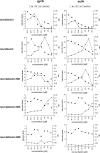Biological activities of novel gyrase inhibitors of the aminocoumarin class
- PMID: 18347114
- PMCID: PMC2415755
- DOI: 10.1128/AAC.01235-07
Biological activities of novel gyrase inhibitors of the aminocoumarin class
Abstract
Thirty-one aminocoumarin antibiotics derived from mutasynthesis experiments were investigated for their biological activities. Their inhibitory activities toward Escherichia coli DNA gyrase were determined in two different in vitro assays: an ATPase assay and a DNA supercoiling assay. The assays gave a similar rank order of the activities of the compounds tested, although the absolute 50% inhibitory concentrations (IC(50)s) obtained in each assay were different. To confirm that the compounds also acted as gyrase inhibitors in vivo, reporter gene assays were carried out with E. coli by using gyrA and sulA promoter fusions with the luxCDABE operon. A strong induction of both promoters was observed for those compounds that showed gyrase inhibitory activity in the biochemical assays. Compounds carrying analogs of the prenylated benzoyl moiety (ring A) of clorobiocin that were structurally very different showed high levels of activity both in the biochemical assay and in the reporter gene assay, indicating that the structure of this moiety can be varied considerably without a loss of affinity for bacterial gyrase. The experimentally determined IC(50)s were compared to the binding energies calculated in silico, which indicated that a shift of the pyrrole carboxylic acid moiety from the O-3'' to the O-2'' position of the deoxysugar moiety has a significant impact on the binding mode of the compounds. The aminocoumarin compounds were also investigated for their MICs against different bacterial pathogens. Several compounds showed high levels of activity against staphylococci, including a methicillin-resistant Staphylococcus aureus strain. However, they showed only poor activities against gram-negative strains.
Figures
Similar articles
-
Antimicrobial and DNA gyrase-inhibitory activities of novel clorobiocin derivatives produced by mutasynthesis.Antimicrob Agents Chemother. 2004 Apr;48(4):1307-12. doi: 10.1128/AAC.48.4.1307-1312.2004. Antimicrob Agents Chemother. 2004. PMID: 15047534 Free PMC article.
-
Inhibition of DNA gyrase and DNA topoisomerase IV of Staphylococcus aureus and Escherichia coli by aminocoumarin antibiotics.J Antimicrob Chemother. 2011 Sep;66(9):2061-9. doi: 10.1093/jac/dkr247. Epub 2011 Jun 21. J Antimicrob Chemother. 2011. PMID: 21693461
-
Structure-activity relationships of aminocoumarin-type gyrase and topoisomerase IV inhibitors obtained by combinatorial biosynthesis.Antimicrob Agents Chemother. 2006 Apr;50(4):1136-42. doi: 10.1128/AAC.50.4.1136-1142.2006. Antimicrob Agents Chemother. 2006. PMID: 16569821 Free PMC article.
-
New aminocoumarin antibiotics as gyrase inhibitors.Int J Med Microbiol. 2014 Jan;304(1):31-6. doi: 10.1016/j.ijmm.2013.08.013. Epub 2013 Sep 4. Int J Med Microbiol. 2014. PMID: 24079980 Review.
-
The interaction between coumarin drugs and DNA gyrase.Mol Microbiol. 1993 Aug;9(4):681-6. doi: 10.1111/j.1365-2958.1993.tb01728.x. Mol Microbiol. 1993. PMID: 8231802 Review.
Cited by
-
DNA Topoisomerases.EcoSal Plus. 2015;6(2):10.1128/ecosalplus.ESP-0010-2014. doi: 10.1128/ecosalplus.ESP-0010-2014. EcoSal Plus. 2015. PMID: 26435256 Free PMC article. Review.
-
Review on plant antimicrobials: a mechanistic viewpoint.Antimicrob Resist Infect Control. 2019 Jul 16;8:118. doi: 10.1186/s13756-019-0559-6. eCollection 2019. Antimicrob Resist Infect Control. 2019. PMID: 31346459 Free PMC article. Review.
-
The Chromosomal parDE2 Toxin-Antitoxin System of Mycobacterium tuberculosis H37Rv: Genetic and Functional Characterization.Front Microbiol. 2016 Jun 14;7:886. doi: 10.3389/fmicb.2016.00886. eCollection 2016. Front Microbiol. 2016. PMID: 27379032 Free PMC article.
-
DNA topoisomerase II is involved in regulation of cyst wall protein genes and differentiation in Giardia lamblia.PLoS Negl Trop Dis. 2013 May 16;7(5):e2218. doi: 10.1371/journal.pntd.0002218. Print 2013. PLoS Negl Trop Dis. 2013. PMID: 23696909 Free PMC article.
-
Challenges of antibacterial discovery.Clin Microbiol Rev. 2011 Jan;24(1):71-109. doi: 10.1128/CMR.00030-10. Clin Microbiol Rev. 2011. PMID: 21233508 Free PMC article. Review.
References
-
- Anderle, C., S. Hennig, B. Kammerer, S. M. Li, L. Wessjohann, B. Gust, and L. Heide. 2007. Improved mutasynthetic approaches for the production of modified aminocoumarin antibiotics. Chem. Biol. 14:955-967. - PubMed
-
- Anderle, C., S. M. Li, B. Kammerer, B. Gust, and L. Heide. 2007. New aminocoumarin antibiotics derived from 4-hydroxycinnamic acid are formed after heterologous expression of a modified clorobiocin biosynthetic gene cluster. J. Antibiot. (Tokyo) 60:504-510. - PubMed
-
- Eady, E. A., and J. H. Cove. 2003. Staphylococcal resistance revisited: community-acquired methicillin resistant Staphylococcus aureus—an emerging problem for the management of skin and soft tissue infections. Curr. Opin. Infect. Dis. 16:103-124. - PubMed
-
- Eder, J. P., C. A. Wheeler, B. A. Teicher, and L. E. Schnipper. 1991. A phase I clinical trial of novobiocin, a modulator of alkylating agent cytotoxicity. Cancer Res. 51:510-513. - PubMed
-
- el Falaha, B. M., A. D. Russell, and J. R. Furr. 1983. Sensitivities of wild-type and envelope-defective strains of Escherichia coli and Pseudomonas aeruginosa to antibacterial agents. Microbios 38:99-105. - PubMed
Publication types
MeSH terms
Substances
LinkOut - more resources
Full Text Sources
Other Literature Sources
Chemical Information
Medical
Molecular Biology Databases



